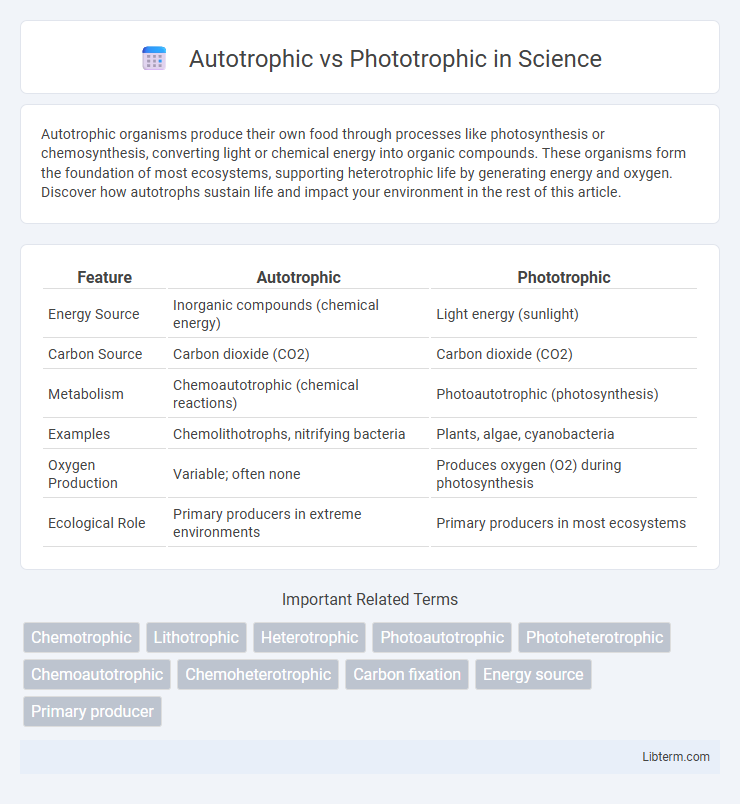Autotrophic organisms produce their own food through processes like photosynthesis or chemosynthesis, converting light or chemical energy into organic compounds. These organisms form the foundation of most ecosystems, supporting heterotrophic life by generating energy and oxygen. Discover how autotrophs sustain life and impact your environment in the rest of this article.
Table of Comparison
| Feature | Autotrophic | Phototrophic |
|---|---|---|
| Energy Source | Inorganic compounds (chemical energy) | Light energy (sunlight) |
| Carbon Source | Carbon dioxide (CO2) | Carbon dioxide (CO2) |
| Metabolism | Chemoautotrophic (chemical reactions) | Photoautotrophic (photosynthesis) |
| Examples | Chemolithotrophs, nitrifying bacteria | Plants, algae, cyanobacteria |
| Oxygen Production | Variable; often none | Produces oxygen (O2) during photosynthesis |
| Ecological Role | Primary producers in extreme environments | Primary producers in most ecosystems |
Understanding Autotrophic Organisms
Autotrophic organisms synthesize their own organic compounds using inorganic substances, primarily through processes such as photosynthesis or chemosynthesis. They play a crucial role in ecosystems as primary producers, converting solar or chemical energy into biomass that sustains heterotrophic life forms. Understanding autotrophic mechanisms, including carbon fixation pathways and energy conversion, is essential for ecological studies and biotechnological applications.
Defining Phototrophic Lifeforms
Phototrophic lifeforms harness light energy to drive their metabolic processes, primarily through photosynthesis, converting solar energy into chemical energy stored as organic compounds. Autotrophic organisms include phototrophs that rely on light as an energy source, distinguishing them from chemoautotrophs that utilize inorganic chemical reactions. Key examples of phototrophic lifeforms are cyanobacteria, algae, and plants, which contribute significantly to global carbon fixation and oxygen production.
Key Differences Between Autotrophs and Phototrophs
Autotrophs synthesize organic molecules from inorganic substances, using either light (photoautotrophs) or chemical energy (chemoautotrophs), whereas phototrophs specifically harness light energy to drive photosynthesis. Autotrophs include both photoautotrophs like plants and algae and chemoautotrophs like certain bacteria, while phototrophs encompass only organisms reliant on light energy such as cyanobacteria and green plants. The primary difference lies in energy acquisition: autotrophs utilize light or chemical energy sources, but phototrophs exclusively depend on light for energy conversion.
Energy Sources: Chemical vs Light
Autotrophic organisms harness energy from inorganic chemical reactions, using substances like hydrogen sulfide or ammonia to drive metabolic processes, classifying them as chemotrophs. Phototrophic organisms capture light energy through pigments such as chlorophyll to perform photosynthesis, converting solar energy into chemical energy. These fundamental differences in energy acquisition define ecological roles and biochemical pathways within diverse environmental niches.
Types of Autotrophic Organisms
Autotrophic organisms are classified into photoautotrophs and chemoautotrophs based on their energy sources, with photoautotrophs like plants, algae, and cyanobacteria harnessing sunlight through photosynthesis. Chemoautotrophs, primarily bacteria such as nitrifying bacteria and sulfur-oxidizing bacteria, derive energy from chemical reactions involving inorganic molecules. These distinctions highlight diverse metabolic pathways enabling autotrophs to convert carbon dioxide into organic compounds essential for ecosystems.
Types of Phototrophic Organisms
Phototrophic organisms harness light energy to synthesize organic compounds through photosynthesis, encompassing diverse types such as cyanobacteria, algae, and plants. Cyanobacteria, often termed blue-green algae, perform oxygenic photosynthesis and contribute significantly to global oxygen production and carbon fixation. Algae range from microscopic phytoplankton to large seaweeds, playing vital roles in aquatic ecosystems, while plants utilize chlorophyll pigments to convert sunlight, water, and carbon dioxide into glucose and oxygen, supporting terrestrial food webs.
Ecological Roles in Different Environments
Autotrophic organisms, such as plants and certain bacteria, convert inorganic carbon into organic matter, playing a critical role in carbon cycling and supporting food webs in terrestrial and aquatic ecosystems. Phototrophic organisms harness sunlight through photosynthesis, contributing to oxygen production and primary productivity in environments ranging from freshwater lakes to oceans. Both groups drive energy flow and nutrient cycling, sustaining diverse habitats and maintaining ecosystem resilience.
Evolutionary Significance of Metabolic Pathways
Autotrophic and phototrophic metabolic pathways represent crucial evolutionary adaptations that allowed organisms to harness energy from inorganic sources and light, respectively, driving the diversification of life on Earth. Autotrophy, particularly through chemosynthesis, enabled early life forms to colonize extreme environments by utilizing chemical energy, while phototrophy introduced oxygenic photosynthesis, significantly altering the planet's atmosphere during the Great Oxygenation Event. The evolution of these metabolic strategies underpinned the development of complex ecosystems by establishing the primary production base essential for sustaining heterotrophic organisms.
Autotrophy and Phototrophy in Biotechnology
Autotrophy in biotechnology harnesses microorganisms or plants that convert inorganic substances like carbon dioxide into organic compounds, essential for sustainable biofuel production and bioremediation. Phototrophy utilizes light energy through photosynthetic organisms, such as cyanobacteria and algae, to drive biochemical reactions critical for biosynthesis and renewable energy generation. Both processes enable eco-friendly innovations in industrial biotechnology by optimizing energy use and carbon fixation pathways.
Future Perspectives in Energy Conversion Research
Future perspectives in energy conversion research emphasize enhancing autotrophic and phototrophic mechanisms for sustainable bioenergy production. Advances in genetic engineering and synthetic biology aim to optimize carbon fixation pathways in autotrophic organisms and improve light-harvesting efficiency in phototrophic species. Integrating these approaches offers potential breakthroughs in developing efficient, renewable energy systems with reduced environmental impact.
Autotrophic Infographic

 libterm.com
libterm.com